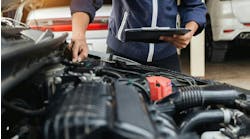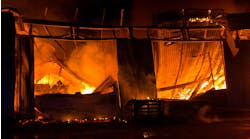By Charles Wilhite
Contributing Editor
Corrode: To eat or wear away gradually as if by gnawing, especially by chemical action (The Random House Dictionary of the English Language).
Corrosion, or rust, has long been a problem with cars. “Rust work” was once the worst work in the shop. Hot rod builders acquired vehicles to work on from the hot, dry parts of the country because those cars and trucks had a lot less rust. For corrosion to begin, the steel or aluminum on a vehicle must be exposed to oxygen and an electrolyte, usually water. On the outside of the vehicle, proper surface preparation and proper primer selection will prevent corrosion. (See “Restoring Corrosion Protection” in the July issue of ABRN.)
The other aspect of protecting vehicles against corrosion is getting to those inside surfaces. Manufacturers go to great lengths to protect the whole vehicle against corrosion. Once a shop repairs or replaces a part, that liability is largely assumed by the shop.
Compromised Protection
Any action that damages the protective layers the factory installs will require attention during the repair process. Some of this is a direct result of the collision’s damage, while other damage can occur during the repair process itself. Hammering, welding, installing pulling studs, some kinds of paintless dent repair (PDR), trimming new parts to fit, and preparing surfaces for welding all remove, scratch or burn the protective layers designed into the part. Using glued pull pads instead of welded studs for minor dent pulling, plastic tips on PDR tools, and taking care to not remove more of the coatings than absolutely necessary when installing a quarter panel, are some precautions that can reduce the impact of repairs on corrosion protection. But, restoring corrosion protection to the internal structure of the vehicle is necessary for a proper repair.
Restoring Protection
As with the outside of the vehicle, the best protection is not to disturb the galvanizing or E-Coating unless it is necessary to make the repairs. While it is true that welds may be compromised by leaving galvanizing and E-Coatings in place, most manufacturers agree that the compromise is an acceptable one. The tradeoff is a very minor strength difference for much better corrosion protection. In many ways, this makes preparation much easier. For years, all mating edges were ground down. Today the recommendation is to remove those coatings only from the surface that will be welded, for instance the 8 mm circle inside the plug weld hole.
Weld-through primer should be placed so it surrounds all welds. The active ingredient in weld through primers is zinc, which protects the edge of the finished weld. The primary function of weld-through primer is to melt into the edge of welds. Because of its limited adhesive properties, it should not be placed, or left in place, on any surface that will later be refinished. Masking edges or using brushable primer can help avoid spraying weld-through primer on to surrounding surfaces.
The second part of restoring corrosion protection is to install protective coatings to the backside of repaired or replaced panels. There are two coatings that must be restored: a primer coating and a moisture barrier. Two types of primer are used to replace the E-Coating: Self-etching and epoxy. Either of these may be used to coat any bare metal surfaces behind a repaired area or inside a frame rail, rocker panel, or pillar that has been sectioned or replaced. These surfaces will need to be cleaned during the assembly process because they may not be accessible later. Careful planning of the repair process may be necessary to allow for access. Moving a section joint a few inches may allow using a hole in an inner panel. A rocker panel with internal reinforcements may require applying corrosion protection before the outside panel is installed.
The last layer of protection is the one installed last at the factory. A wax- or petroleum-based anti-corrosion coating is applied on most inside, closed surfaces, such as inside frame rails. This is considered a redundant protective coating. The coating is somewhat flexible and will migrate into all areas of the body. Each of these coatings is installed with a 360

